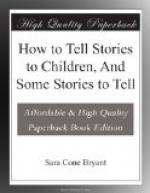It is not particularly useful to tell batches of unrelated anecdote. It is much more profitable to take up the story of a period and connect it with a group of interesting persons whose lives affected it or were affected by it, telling the stories of their lives, or of the events in which they were concerned, as “true stories.” These biographical stories must, usually, be adapted for use. But besides these there is a certain number of pure stories—works of art—which already exist for us, and which illuminate facts and epochs almost without need of sidelights. Such may stand by themselves, or be used with only enough explanation to give background. Probably the best story of this kind known to lovers of modern literature is Daudet’s famous La Derniere Classe.[1]
[Footnote 1: See The Last Lesson, page 238.]
The historical story, to recapitulate, gives a sense of the reality and humanness of past events, is a valuable aid in patriotic training, and stirs the desire of emulating goodness and wisdom.
CHAPTER II
SELECTION OF STORIES TO TELL
There is one picture which I can always review, in my own collection of past scenes, though many a more highly coloured one has been irrevocably curtained by the folds of forgetfulness. It is the picture of a little girl, standing by an old-fashioned marble-topped dressing-table in a pink, sunny room. I can never see the little girl’s face, because, somehow, I am always looking down at her short skirts or twisting my head round against the hand which patiently combs her stubborn curls. But I can see the brushes and combs on the marble table quite plainly, and the pinker streaks of sun on the pink walls. And I can hear. I can hear a low, wonder-working




